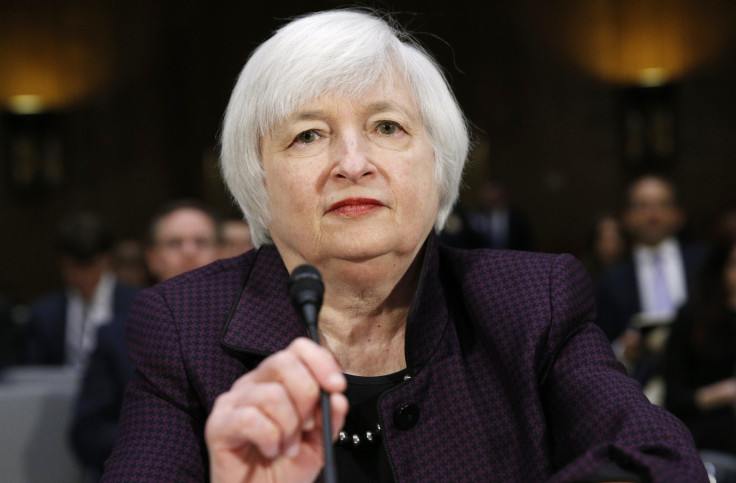Federal Reserve System: 3 Things To Know Ahead Of Janet Yellen Speech, FOMC Statement

Financial markets are bracing for a highly anticipated announcement from the U.S. Federal Reserve Wednesday that will shed light on when the central bank plans to increase interest rates. The Fed has held rates at historic lows since the financial crisis in 2008 to help the economy emerge from the recession. But after nearly seven years those abnormally low interest rates have taken their own toll on the economy: Corporate debt has ballooned; stock and bond markets have boomed; and real estate prices have skyrocketed.
The Fed has signaled recently that it could begin returning interest rates to normal levels sometime in the next six months.
When it comes, the rate hike will have broad effects on the U.S. economy and consumers as windows of opportunity narrow on financial products including low mortgage refinancing rates and zero percent financing on credit cards.
The Federal Open Market Committee (FOMC) is scheduled to release a statement Wednesday at 2 p.m. EDT, followed by a press conference from Fed Chair Janet Yellen at 2:30 p.m. EDT.
Here's what to know ahead of the Fed's announcement.
Words To Watch
The Fed’s guiding principle since December has been that it will remain patient about raising rates, but economists and market professionals expect the word “patient” to be dropped from the Fed’s statement Wednesday, giving the central bank the option -- but not necessarily the obligation -- to raise interest rates as soon as June, should conditions warrant, says Greg McBride, chief financial analyst at Bankrate.com. In a December 2014 statement the Federal Reserve removed "considerable time" from its description of how long it would wait to raise interest rates. That was interpreted as signaling that the central bank could raise interest rates sometime this year.
Since the start of 2015, however, a series of housing, retail and inflation indicators have missed forecasts, meaning the economy may not be in the best shape to withstand rate hikes. The Fed, therefore, is not under immense pressure to outline a specific time for when interest rates will go higher.
“The Fed could remove ‘patient’ and simply replace it with a word that’s not as strong,” said Mark Newton, chief technical analyst at Greywolf Execution Partners Inc.
Federal Reserve Chair Janet Yellen announced last month during her semiannual Humphrey-Hawkins testimony before Congress that the central bank will not raise interest rates for the “next couple of FOMC meetings,” citing low energy costs and low inflation, alongside an improving job market as part of her reasoning. The FOMC holds eight regularly scheduled meetings each year.
Yellen also warned that removal of the "patient" wording in an upcoming FOMC statement would not mean the Fed "will necessarily increase" interest rates within two meetings.
Data To Deliberate
The Fed will also release its updated projections for the U.S. economy over the next three years. Economists are likely to hone in on two key details: growth in the gross domestic product (GDP) and inflation. GDP, the broadest measure of goods and services produced across the economy, was revised down to an annualized 2.2 percent in the fourth quarter of last year, slower than initially forecast. With a strengthening U.S. dollar, coupled with harsh winter weather, the first quarter is also likely to be weaker than previously anticipated.
Economists are expecting weak inflation readings later this year due to the dramatic drop in energy prices since last June. Such expectations will likely delay a rate hike until the fall, said Gregory Daco, chief U.S. economist at Oxford Economics.
McBride agrees. “If we see the Fed is revising down expectations for inflation, that’s indicative of a central bank that’s not in a hurry to raise rates,” he said.
Economists will also be listening to Yellen’s speech to hear more about whether a recent surge in the U.S. dollar will affect the Fed's inflation goal of 2 percent.
Why It Matters To Consumers
For the average U.S. consumer who’s working and putting money in a 401(k) every payday, the Fed’s inevitable rate hike will affect three key things:
Refinance rates on mortgages, zero percent introductory rates on credit cards and variable debt rates.
Fixed rates for the benchmark 30-year and 15-year mortgages are both below 4 percent, meaning now is a more opportune time to refinance a mortgage. There’s no guarantee that rates are going to stay below 4 percent as the year progresses, McBride said.
Consumers should also try to snag zero percent introductory rates and balance transfer offers on credit cards now. As the Fed moves away from zero percent interest rates, credit card issuers are likely to do the same. Now is also an opportunity to chip away at variable debt before interest rates begin to climb, including credit cards, student loans and home equity lines of credit.
© Copyright IBTimes 2024. All rights reserved.












